We are a group company of SCREEN Holdings Co., Ltd.
MED Probe
MED Probe [MED-P2105, MED-P210A, MED-R2105, MED-R210A]
- Sixty-four planar microelectrodes are arranged in an 8 x 8 grid embeded in the center of a transparent glass substrate.
- Any of the 64 electrodes can be used for stimulation (up to two simultaneously for current-driven stimulus).
- The industory's lowest-impedance microelectrodes provide excellent signal-to-noise ratio as well as stimulation capabilities.
- In addition to the original platinum-black electrode type MED probe (MED-P****), more durable carbon nanotube electrode type MED probe (MED-R****) can be chosen.
- It is supported on MED64-Basic.
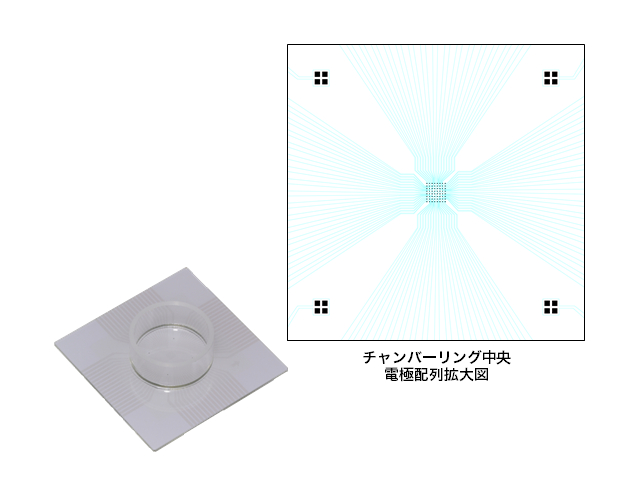
- SPECIFICATIONS
-
Materials Substrate Glass, T=0.7 mm Conducting layer ITO (Indium Tin Oxide), T=0.15 μm Insulation layer Polyimide Electrodes MED-P****: platinum black
MED-R****: carbon nanotubeChamber ring Glass General Information Substrate size 50 x 50 mm Number of recording electrodes 64 Recording electrodes size 20 x 20 μm Recording electrodes spacing 100 μm Number of reference electrodes 16 Reference electrodes size 200 x 200 μm Reference electrodes blocks spacing 8.5 mm Electrode impedance (f= 1kHz) Typ. 15 kΩ Maximum current output ±200 μA (t=300 μS) Maximum voltage output ±1 V Chamber ring size OD25/ ID22 mm Chamber ring height MED-****5: 5 mm
MED-****A: 10 mm
MED Probe [MED-P5155, MED-P515A, MED-R5155, MED-R515A]
- Sixty-four planar microelectrodes are arranged in an 8 x 8 grid embeded in the center of a transparent glass substrate.
- Any of the 64 electrodes can be used for stimulation (up to two simultaneously for current-driven stimulus).
- The industory's lowest-impedance microelectrodes provide excellent signal-to-noise ratio as well as stimulation capabilities.
- In addition to the original platinum-black electrode type MED probe (MED-P****), more durable carbon nanotube electrode type MED probe (MED-R****) can be chosen.
- It is supported on MED64-Basic.
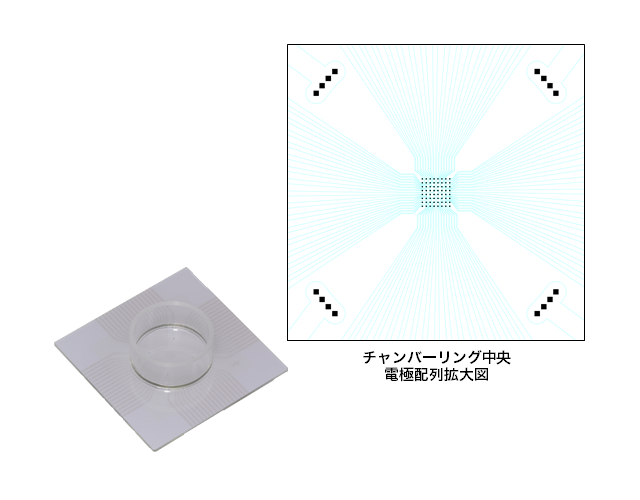
- SPECIFICATIONS
-
Materials Substrate Glass, T=0.7 mm Conducting layer ITO (Indium Tin Oxide), T=0.15 μm Insulation layer Polyimide Electrodes MED-P****: platinum black
MED-R****: carbon nanotubeChamber ring Glass General Information Substrate size 50 x 50 mm Number of recording electrodes 64 Recording electrodes size 50 x 50 μm Recording electrodes spacing 150 μm Number of reference electrodes 16 Reference electrodes size 200 x 200 μm Reference electrodes blocks spacing 8.5 mm Electorde impedance (f= 1kHz) Typ. 10 kΩ Maximum current output ±200 μA (t=300 μS) Maximum voltage output ±1 V Chamber ring size OD25/ ID22 mm Chamber ring height MED-****5: 5 mm
MED-****A: 10 mm
MED Probe [MED-P530, MED-P530A, MED-R5305, MED-R530A]
- Sixty-four planar microelectrodes are arranged in an 8 x 8 grid embeded in the center of a transparent glass substrate.
- Any of the 64 electrodes can be used for stimulation (up to two simultaneously for current-driven stimulus).
- The industory's lowest-impedance microelectrodes provide excellent signal-to-noise ratio as well as stimulation capabilities.
- In addition to the original platinum-black electrode type MED probe (MED-P****), more durable carbon nanotube electrode type MED probe (MED-R****) can be chosen.
- It is supported on MED64-Basic.
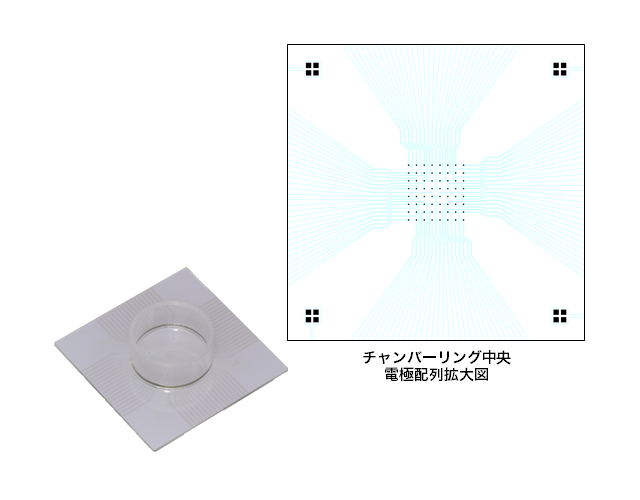
- SPECIFICATIONS
-
Materials Substrate Glass, T=0.7 mm Conducting layer ITO (Indium Tin Oxide), T=0.15 μm Insulation layer Polyimide Electrodes MED-P****: platinum black
MED-R****: carbon nanotubeChamber ring Glass General Information Substrate size 50 x 50 mm Number of recording electrodes 64 Recording electrodes size 50 x 50 μm Recording electrodes spacing 300 μm Number of reference electrodes 16 Reference electrodes size 200 x 200 μm Reference electrodes blocks spacing 9.2 mm Electrode impedance (f= 1kHz) Typ. 10 kΩ Maximum current output ±200 μA (t=300 μS) Maximum voltage output ±1 V Chamber ring size OD25/ ID22 mm Chamber ring height MED-****5: 5 mm
MED-****A: 10 mm
MED Probe [MED-P5455, MED-P545A, MED-R5455, MED-R545A]
- Sixty-four planar microelectrodes are arranged in an 8 x 8 grid embeded in the center of a transparent glass substrate.
- Any of the 64 electrodes can be used for stimulation (up to two simultaneously for current-driven stimulus).
- The industory's lowest-impedance microelectrodes provide excellent signal-to-noise ratio as well as stimulation capabilities.
- In addition to the original platinum-black electrode type MED probe (MED-P****), more durable carbon nanotube electrode type MED probe (MED-R****) can be chosen.
- It is supported on MED64-Basic.
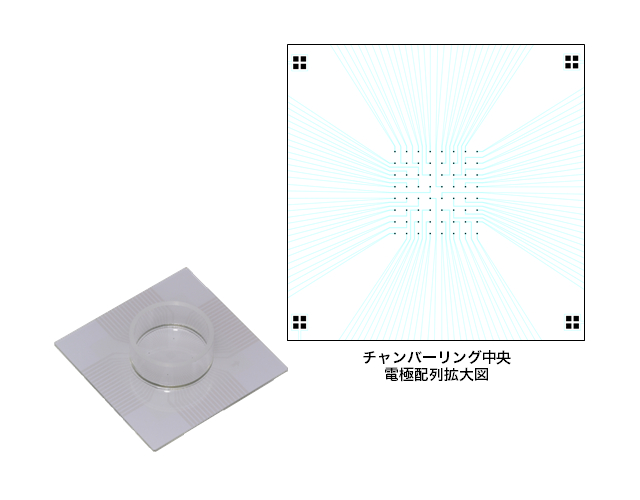
- SPECIFICATIONS
-
Materials Substrate Glass, T=0.7 mm Conducting layer ITO (Indium Tin Oxide), T=0.15 μm Insulation layer Polyimide Electrodes MED-P****: platinum black
MED-R****: carbon nanotubeChamber ring Glass General Information Substrate size 50 x 50 mm Number of recording electrodes 64 Recording electrodes size 50 x 50 μm Recording electrodes spacing 450 μm Number of reference electrodes 16 Reference electrodes size 200 x 200 μm Reference electrodes blocks spacing 10 mm Electrode impedance (f= 1kHz) Typ. 10 kΩ Maximum current output ±200 μA (t=300 μS) Maximum voltage output ±1 V Chamber ring size OD25/ ID22 mm Chamber ring height MED-****5: 5 mm
MED-****A: 10 mm
MED Probe [MED-P50015, MED-P5001A, MED-R50015, MED-R5001A]
- Sixty-four planar microelectrodes are arranged in an 8 x 8 grid embeded in the center of a transparent glass substrate.
- Any of the 64 electrodes can be used for stimulation (up to two simultaneously for current-driven stimulus).
- The industory's lowest-impedance microelectrodes provide excellent signal-to-noise ratio as well as stimulation capabilities.
- In addition to the original platinum-black electrode type MED probe (MED-P****), more durable carbon nanotube electrode type MED probe (MED-R****) can be chosen.
- It is supported on MED64-Basic.
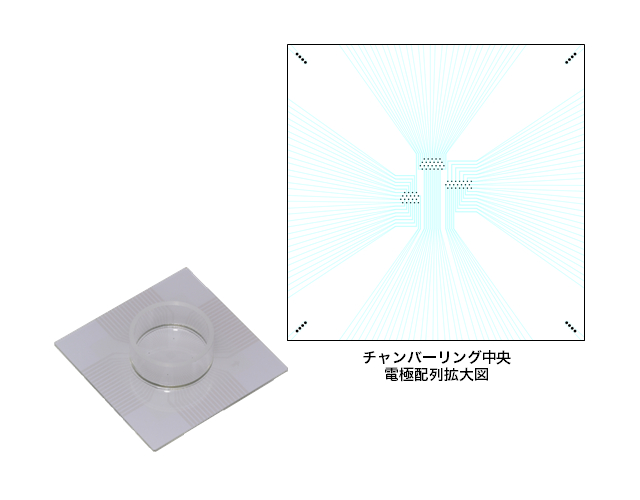
- SPECIFICATIONS
-
Materials Substrate Glass, T=0.7 mm Conducting layer ITO (Indium Tin Oxide), T=0.15 μm Insulation layer Polyimide Electrodes MED-P****: platinum black
MED-R****: carbon nanotubeChamber ring Glass General Information Substrate size 50 x 50 mm Number of recording electrodes 64 Recording electrodes size Φ20 μm Recording electrodes spacing 150 μm Number of reference electrodes 16 Reference electrodes size Φ100 μm Reference electrodes blocks spacing 10 mm Electrode impedance (f= 1kHz) Typ. 10 kΩ Maximum current output ±200 μA (t=300 μS) Maximum voltage output ±1 V Chamber ring size OD25/ ID22 mm Chamber ring height MED-****5: 5 mm
MED-****A: 10 mm
MED Probe [MED-P50025, MED-P5002A, MED-R50025, MED-R5002A]
- Sixty-four planar microelectrodes are arranged in an 8 x 8 grid embeded in the center of a transparent glass substrate.
- Any of the 64 electrodes can be used for stimulation (up to two simultaneously for current-driven stimulus).
- The industory's lowest-impedance microelectrodes provide excellent signal-to-noise ratio as well as stimulation capabilities.
- In addition to the original platinum-black electrode type MED probe (MED-P****), more durable carbon nanotube electrode type MED probe (MED-R****) can be chosen.
- It is supported on MED64-Basic.
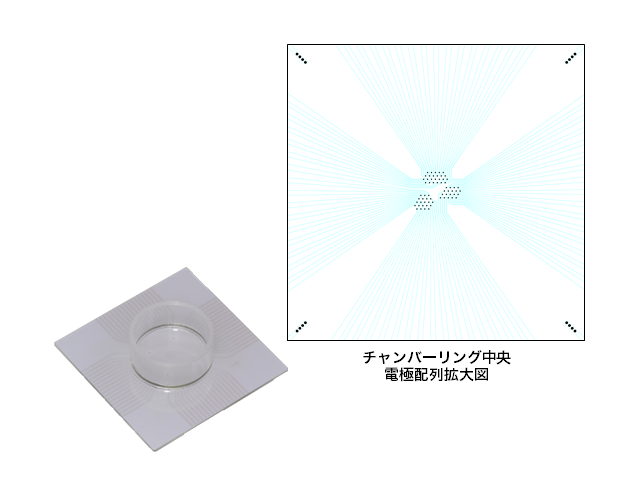
- SPECIFICATIONS
-
Materials Substrate Glass, T=0.7 mm Conducting layer ITO (Indium Tin Oxide), T=0.15 μm Insulation layer Polyimide Electrodes MED-P****: platinum black
MED-R****: carbon nanotubeChamber ring Glass General Information Substrate size 50 x 50 mm Number of recording electrodes 64 Recording electrodes size Φ20 μm Recording electrodes spacing 150 μm Number of reference electrodes 16 Reference electrodes size Φ100 μm Reference electrodes blocks spacing 10 mm Electrode impedance (f= 1kHz) Typ. 10 kΩ Maximum current output ±200 μA (t=300 μS) Maximum voltage output ±1 V Chamber ring size 外径25/ 内径22 mm Chamber ring height MED-****5: 5 mm
MED-****A: 10 mm
MED Probe [MED-P2H075, MED-P2H07A, MED-R2H075, MED-R2H07A]
- Sixty-four planar microelectrodes are arranged in an 8 x 8 grid embeded in the center of a transparent glass substrate.
- Any of the 64 electrodes can be used for stimulation (up to two simultaneously for current-driven stimulus).
- The industory's lowest-impedance microelectrodes provide excellent signal-to-noise ratio as well as stimulation capabilities.
- In addition to the original platinum-black electrode type MED probe (MED-P****), more durable carbon nanotube electrode type MED probe (MED-R****) can be chosen.
- It is supported on MED64-Basic.
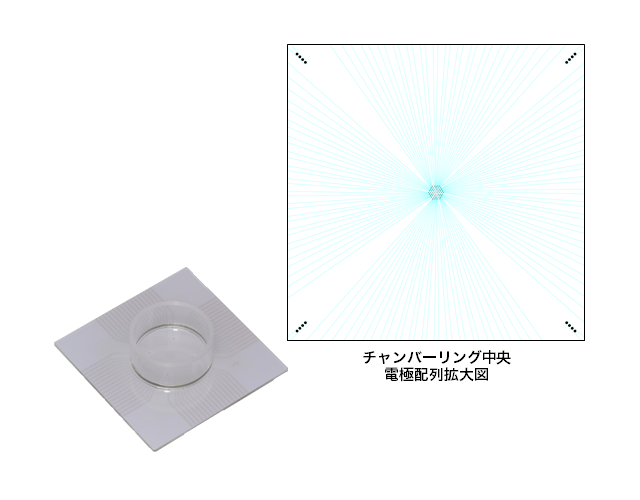
- SPECIFICATIONS
-
Materials Substrate Glass, T=0.7 mm Conducting layer ITO (Indium Tin Oxide), T=0.15 μm Insulation layer Polyimide Electrodes MED-P****: platinum black
MED-R****: carbon nanotubeChamber ring Glass General Information Substrate size 50 x 50 mm Number of recording electrodes 61 Recording electrodes size Φ20 μm Recording electrodes spacing 70 μm Number of reference electrodes 16 Reference electrodes size Φ100 μm Reference electrodes blocks spacing 10 mm Electrode impedance (f= 1kHz) Typ. 15 kΩ Maximum current output ±200 μA (t=300 μS) Maximum voltage output ±1 V Chamber ring size OD25/ ID22 mm Chamber ring height MED-****5: 5 mm
MED-****A: 10 mm
MED Probe [MED-P50035, MED-P5003A, MED-R50035, MED-R5003A]
- Sixty-four planar microelectrodes are arranged in an 8 x 8 grid embeded in the center of a transparent glass substrate.
- Any of the 64 electrodes can be used for stimulation (up to two simultaneously for current-driven stimulus).
- The industory's lowest-impedance microelectrodes provide excellent signal-to-noise ratio as well as stimulation capabilities.
- In addition to the original platinum-black electrode type MED probe (MED-P****), more durable carbon nanotube electrode type MED probe (MED-R****) can be chosen.
- It is supported on MED64-Basic.
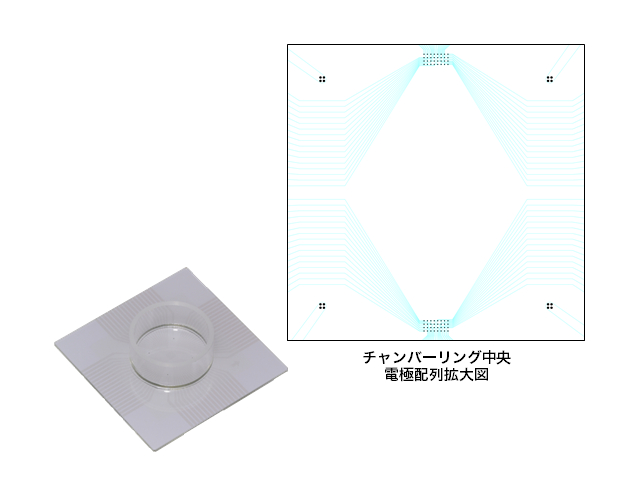
- SPECIFICATIONS
-
Materials Substrate Glass, T=0.7 mm Conducting layer ITO (Indium Tin Oxide), T=0.15 μm Insulation layer Polyimide Electrodes MED-P****: platinum black
MED-R****: carbon nanotubeChamber ring Glass General Information Substrate size 50 x 50 mm Number of recording electrodes 64 Recording electrodes size Φ50 μm Recording electrodes spacing 150 μm Number of reference electrodes数 16 Reference electrodes size Φ100 μm Reference electrodes blocks spacing 10 mm Electrode impedance (f= 1kHz) Typ. 10 kΩ Maximum current output ±200 μA (t=300 μS) Maximum voltage output ±1 V Chamber ring size OD25/ ID22 mm Chamber ring height MED-****5: 5 mm
MED-****A: 10 mm
MED Probe [MED-P50045, MED-P5004A, MED-R50045, MED-R5004A]
- Sixty-four planar microelectrodes are arranged in an 8 x 8 grid embeded in the center of a transparent glass substrate.
- Any of the 64 electrodes can be used for stimulation (up to two simultaneously for current-driven stimulus).
- The industory's lowest-impedance microelectrodes provide excellent signal-to-noise ratio as well as stimulation capabilities.
- In addition to the original platinum-black electrode type MED probe (MED-P****), more durable carbon nanotube electrode type MED probe (MED-R****) can be chosen.
- It is supported on MED64-Basic.
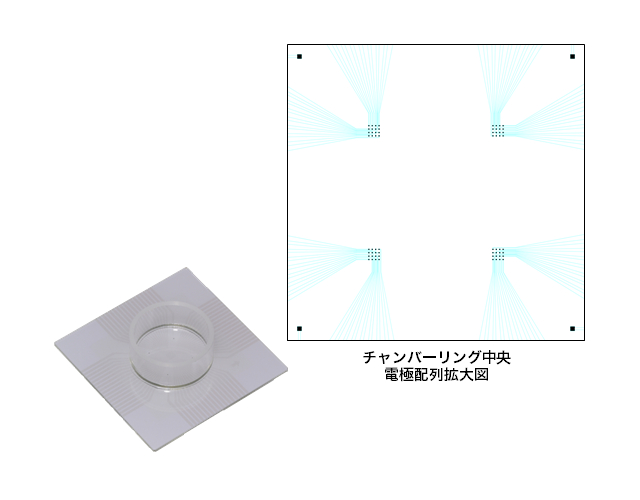
- SPECIFICATIONS
-
Materials Substrate Glass, T=0.7 mm Conducting layer ITO (Indium Tin Oxide), T=0.15 μm Insulation layer Polyimide Electrodes MED-P****: platinum black
MED-R****: carbon nanotubeChamber ring Glass General Information Substrate size 50 x 50 mm Number of recording electrodes 64 Recording electrodes size 50 x 50 μm Recording electrodes spacing 150 μm Number of reference electrodes 4 Reference electrodes size 200 x 200 μm Reference electrodes blocks spacing 12 mm Electrode impedance (f= 1kHz) Typ. 10 kΩ Maximum current output ±200 μA (t=300 μS) Maximum voltage output ±1 V Chamber ring size OD25/ ID22 mm Chamber ring height MED-****5: 5 mm
MED-****A: 10 mm
MED Probe [MED-P5D15A, MED-P5D15B, MED-R5D15A, MED-R5D15B]
- Sixty-four planar microelectrodes are arranged in an 8 x 8 grid embeded in the center of a transparent glass substrate.
- Any of the 64 electrodes can be used for stimulation (up to two simultaneously for current-driven stimulus).
- The industory's lowest-impedance microelectrodes provide excellent signal-to-noise ratio as well as stimulation capabilities.
- In addition to the original platinum-black electrode type MED probe (MED-P****), more durable carbon nanotube electrode type MED probe (MED-R****) can be chosen.
- It is supported on MED64-Basic.
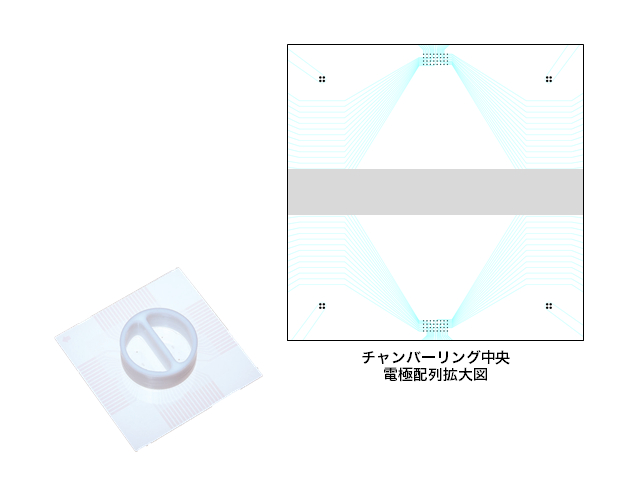
- SPECIFICATIONS
-
Materials Substrate Glass, T=0.7 mm Conducting layer ITO (Indium Tin Oxide), T=0.15 μm Insulation layer Polyimide Electrodes MED-P****: platinum black
MED-R****: carbon nanotubeChamber ring Acrylic resin General Information Substrate size 50 x 50 mm Number of recording electrodes 64 Recording electrodes size Φ50 μm Recording electrodes spacing 150 μm Number of reference electrodes 16 Reference electrodes size Φ100 μm Reference electrodes blocks spacing 10 mm Electrode impedance (f= 1kHz) Typ. 10 kΩ Maximum current output ±200 μA (t=300 μS) Maximum voltage output ±1 V Chamber ring size OD25/ ID22 mm Chamber ring height 10 mm Divider height MED-****A: 10 mm
MED-****B: 5 mm
MED Probe [MED-P5DF15, MED-R5DF15]
- Sixty-four planar microelectrodes are arranged in an 8 x 8 grid embeded in the center of a transparent glass substrate.
- Any of the 64 electrodes can be used for stimulation (up to two simultaneously for current-driven stimulus).
- The industory's lowest-impedance microelectrodes provide excellent signal-to-noise ratio as well as stimulation capabilities.
- In addition to the original platinum-black electrode type MED probe (MED-P****), more durable carbon nanotube electrode type MED probe (MED-R****) can be chosen.
- It is supported on MED64-Basic.
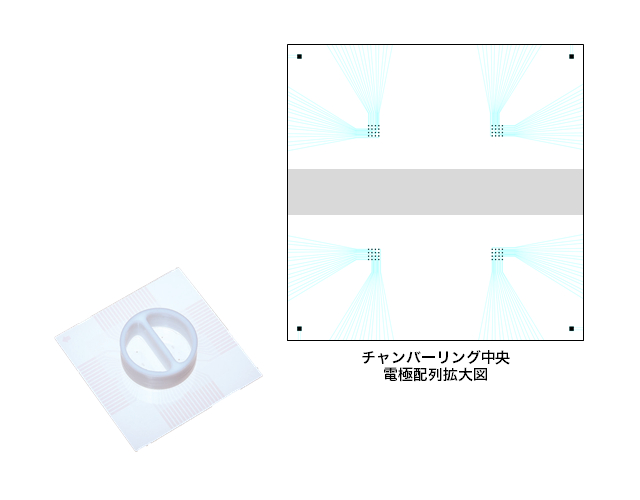
- SPECIFICATIONS
-
Materials Substrate Glass, T=0.7 mm Conducting layer ITO (Indium Tin Oxide), T=0.15 μm Insulation layer Polyimide Electrodes MED-P****: platinum black
MED-R****: carbon nanotubeChamber ring Acrylic resin General Information Substrate size 50 x 50 mm Number of recording electrodes 64 Recording electrodes size 50 x 50 μm Recording electrodes spacing 150 μm Number of reference electrodes 4 Reference electrodes size 200 x 200 μm Reference electrodes blocks spacing 12 mm Electrode impedance (f= 1kHz) Typ. 10 kΩ Maximum current output ±200 μA (t=300 μS) Maximum voltage output ±1 V Chamber ring size OD25/ ID22 mm Chamber ring height 10 mm Divider height 10 mm
MED Probe [MED-P5FF15, MED-R5FF15]
- Sixty-four planar microelectrodes are arranged in an 8 x 8 grid embeded in the center of a transparent glass substrate.
- Any of the 64 electrodes can be used for stimulation (up to two simultaneously for current-driven stimulus).
- The industory's lowest-impedance microelectrodes provide excellent signal-to-noise ratio as well as stimulation capabilities.
- In addition to the original platinum-black electrode type MED probe (MED-P****), more durable carbon nanotube electrode type MED probe (MED-R****) can be chosen.
- It is supported on MED64-Basic.
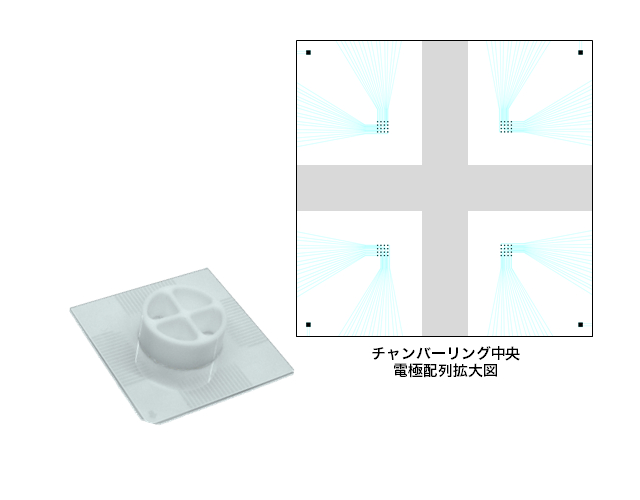
- SPECIFICATIONS
-
Materials Substrate Glass, T=0.7 mm Conducting layer ITO (Indium Tin Oxide), T=0.15 μm Insulation layer Polyimide Electrodes MED-P****: platinum black
MED-R****: carbon nanotubeChamber ring Acrylic resin General Information Substrate size 50 x 50 mm Number of recording electrodes 64 Recording electrodes size 50 x 50 μm Recording electrodes spacing 150 μm Number of reference electrodes 4 Reference electrodes size 200 x 200 μm Reference electrodes blocks spacing 12 mm Electrode impedance (f= 1kHz) Typ. 10 kΩ Maximum current output ±200 μA (t=300 μS) Maximum voltage output ±1 V Chamber ring size OD25/ ID22 mm Chamber ring height 10 mm Divider height 10 mm
MED Probe 16
MED Probe 16 [MED-PG515A, MED-RG515A]
- Sixteen planar microelectrodes are arranged in an 4 x 4 grid embeded in the center of a transparent glass substrate.
- Any of the 16 electrodes can be used for stimulation (up to two simultaneously for current-driven stimulus).
- The industory's lowest-impedance microelectrodes provide excellent signal-to-noise ratio as well as stimulation capabilities.
- In addition to the original platinum-black electrode type MED probe (MED-P****), more durable carbon nanotube electrode type MED probe (MED-R****) can be chosen.
- It is supported on MED64-Quad II.
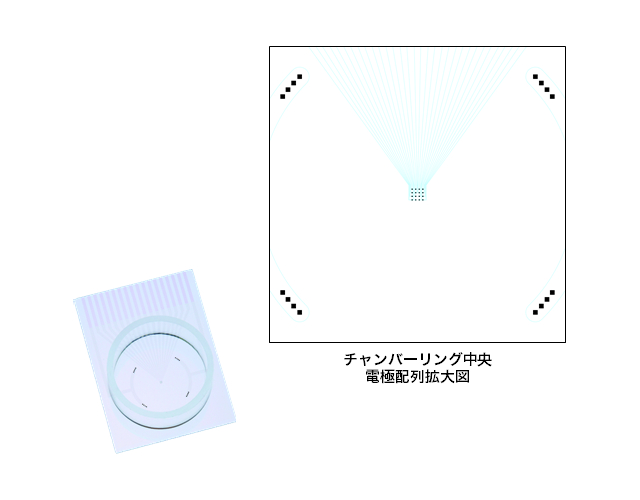
- SPECIFICATIONS
-
Materials Substrate Glass, T=0.7 mm Conducting layer ITO (Indium Tin Oxide), T=0.15 μm Insulation layer Polyimide Electrodes MED-P****: platinum black
MED-R****: carbon nanotubeChamber ring Glass General Information Substrate size 30 x 40 mm Number of recording electrodes 16 Recording electrodes size 50 x 50 μm Recording electrodes spacing 150 μm Number of reference electrodes 16 Reference electrodes size 200 x 200 μm Reference electrodes blocks spacing 14 mm Electrode impedance (f= 1kHz) Typ. 10 kΩ Maximum current output ±200 μA (t=300 μS) Maximum voltage output ±1 V Chamber ring size OD25/ ID22 mm Chamber ring height 10 mm
MED Probe 16 [MED-PG501A, MED-RG501A]
- Sixteen planar microelectrodes are arranged in an 2 x 8 grid embeded in the center of a transparent glass substrate.
- Any of the 16 electrodes can be used for stimulation (up to two simultaneously for current-driven stimulus).
- The industory's lowest-impedance microelectrodes provide excellent signal-to-noise ratio as well as stimulation capabilities.
- In addition to the original platinum-black electrode type MED probe (MED-P****), more durable carbon nanotube electrode type MED probe (MED-R****) can be chosen.
- It is supported on MED64-Quad II.
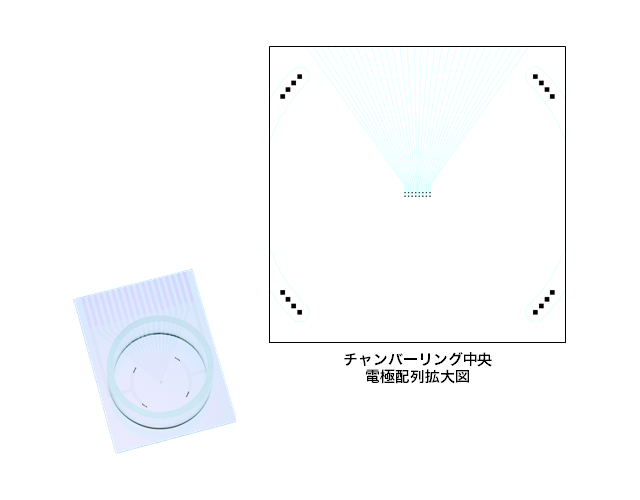
- SPECIFICATIONS
-
Materials Substrate Glass, T=0.7 mm Conducting layer ITO (Indium Tin Oxide), T=0.15 μm Insulation layer Polyimide Electrodes MED-P****: platinum black
MED-R****: carbon nanotubeChamber ring Glass General Information Substrate size 30 x 40 mm Number of recording electrodes 16 Recording electrodes size 50 x 50 μm Recording electrodes spacing 150 μm Number of reference electrodes 16 Reference electrodes size 200 x 200 μm Reference electrodes blocks spacing 14 mm Electrode impedance (f= 1kHz) Typ. 10 kΩ Maximum current output ±200 μA (t=300 μS) Maximum voltage output ±1 V Chamber ring size OD25/ ID22 mm Chamber ring height 10 mm
MED Probe 16 [MED-PG207A, MED-RG207A]
- Sixteen planar microelectrodes are arranged in an 4 x 4 grid embeded in the center of a transparent glass substrate.
- Any of the 16 electrodes can be used for stimulation (up to two simultaneously for current-driven stimulus).
- The industory's lowest-impedance microelectrodes provide excellent signal-to-noise ratio as well as stimulation capabilities.
- In addition to the original platinum-black electrode type MED probe (MED-P****), more durable carbon nanotube electrode type MED probe (MED-R****) can be chosen.
- It is supported on MED64-Quad II.
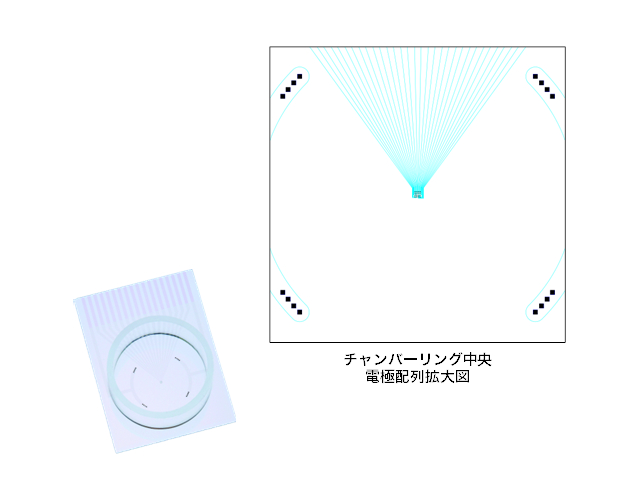
- SPECIFICATIONS
-
Materials Substrate Glass, T=0.7 mm Conducting layer ITO (Indium Tin Oxide), T=0.15 μm Insulation layer Polyimide Electrodes MED-P****: platinum black
MED-R****: carbon nanotubeChamber ring Glass General Information Substrate size 30 x 40 mm Number of recording electrodes 16 Recording electrodes size 20 x 20 μm Recording electrodes spacing 70 μm Number of reference electrodes 16 Reference electrodes size 200 x 200 μm Reference electrodes blocks spacing 14 mm Electrode impedance (f= 1kHz) Typ. 10 kΩ Maximum current output ±200 μA (t=300 μS) Maximum voltage output ±1 V Chamber ring size OD25/ ID22 mm Chamber ring height 10 mm
MED Probe 16 [MED-PG530A, MED-RG530A]
- Sixteen planar microelectrodes are arranged in an 4 x 4 grid embeded in the center of a transparent glass substrate.
- Any of the 16 electrodes can be used for stimulation (up to two simultaneously for current-driven stimulus).
- The industory's lowest-impedance microelectrodes provide excellent signal-to-noise ratio as well as stimulation capabilities.
- In addition to the original platinum-black electrode type MED probe (MED-P****), more durable carbon nanotube electrode type MED probe (MED-R****) can be chosen.
- It is supported on MED64-Quad II.
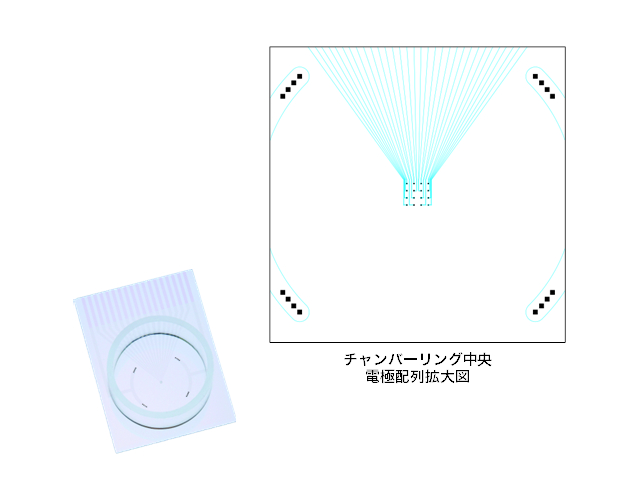
- SPECIFICATIONS
-
Materials Substrate Glass, T=0.7 mm Conducting layer ITO (Indium Tin Oxide), T=0.15 μm Insulation layer Polyimide Electrodes MED-P****: platinum black
MED-R****: carbon nanotubeChamber ring Glass General Information Substrate size 30 x 40 mm Number of recording electrodes 16 Recording electrodes size 50 x 50 μm Recording electrodes spacing 300 μm Number of reference electrodes 16 Reference electrodes size 200 x 200 μm Reference electrodes blocks spacing 14 mm Electrode impedance (f= 1kHz) Typ. 10 kΩ Maximum current output ±200 μA (t=300 μS) Maximum voltage output ±1 V Chamber ring size OD25/ ID22 mm Chamber ring height 10 mm
MED Multi-well Probe
MED Multi-well Probe [MED-P5NF30, MED-R5NF30]
- Sixteen planar microelectrodes are arranged in the each center of 4 wells on a transparent glass substrate.
- Any of the 64 electrodes can be used for stimulation (up to two simultaneously for current-driven stimulus).
- The industory's lowest-impedance microelectrodes provide excellent signal-to-noise ratio as well as stimulation capabilities.
- In addition to the original platinum-black electrode type MED probe (MED-P****), more durable carbon nanotube electrode type MED probe (MED-R****) can be chosen.
- It is supported on MED64-Allegro.
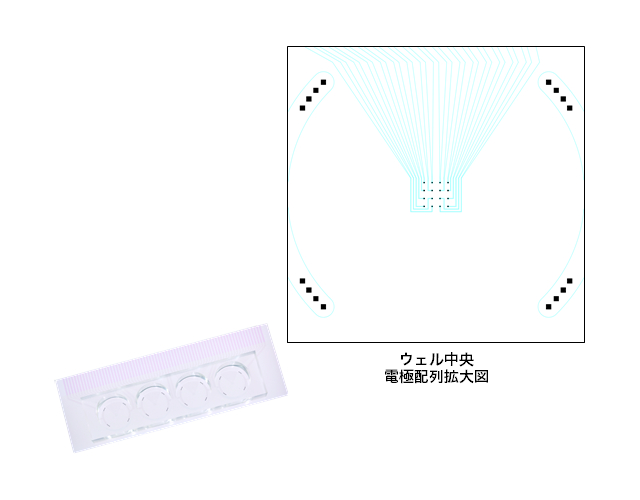
- SPECIFICATIONS
-
Materials Substrate Glass, T=0.7 mm Conducting layer ITO (Indium Tin Oxide), T=0.15 μm Insulation layer Polyimide Electrodes MED-P****: platinum black
MED-R****: carbon nanotubeChamber ring Glass General Information Substrate size 100 x 35 mm Number of recording electrodes 16/well Recording electrodes size 50 x 50 μm Recording electrodes spacing 300 μm Number of reference electrodes 16/well Reference electrodes size 200 x 200 μm Reference electrodes blocks spacing 12 mm Electrode impedance (f= 1kHz) Typ. 10 kΩ Maximum current output ±200 μA (t=300 μS) Maximum voltage output ±1 V Number of wells 4 Well size Φ16 mm Well height 10 mm
MED Multi-well Probe [MED-P5N811, MED-R5N811]
- Eight planar microelectrodes are arranged in the each center of 8 wells on a transparent glass substrate.
- Any of the 64 electrodes can be used for stimulation (up to two simultaneously for current-driven stimulus).
- The industory's lowest-impedance microelectrodes provide excellent signal-to-noise ratio as well as stimulation capabilities.
- In addition to the original platinum-black electrode type MED probe (MED-P****), more durable carbon nanotube electrode type MED probe (MED-R****) can be chosen.
- It is supported on MED64-Allegro.
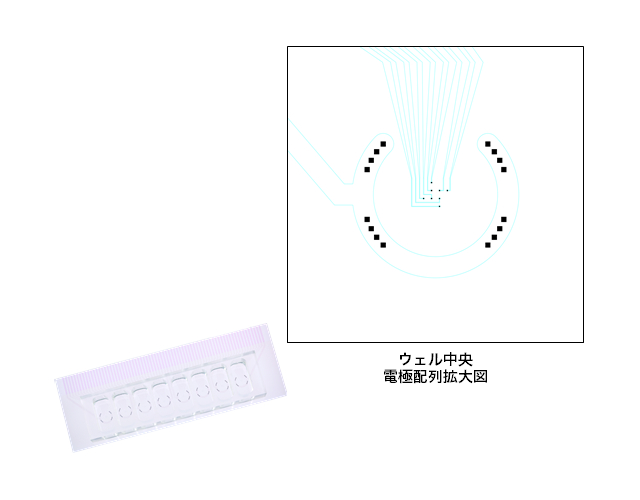
- SPECIFICATIONS
-
Materials Substrate Glass, T=0.7 mm Conducting layer ITO (Indium Tin Oxide), T=0.15 μm Insulation layer Polyimide Electrodes MED-P****: platinum black
MED-R****: carbon nanotubeChamber ring Acrylic resin General Information Substrate size 100 x 35 mm Number of recording electrodes 8/well Recording electrodes size 50 x 50 μm Recording electrodes spacing 300 μm Number of reference electrodes 16/well Reference electrodes size 200 x 200 μm Reference electrodes blocks spacing 5.5 mm Electrode impedance (f= 1kHz) Typ. 10 kΩ Maximum current output ±200 μA (t=300 μS) Maximum voltage output ±1 V Number of wells 8 Well size 7.5 x 16 mm Well height 10 mm
MEA Plate
MEA Plate [MED-Q2430L]
- Sixteen planar microelectrodes are arranged in the each center of 24 wells on a transparent glass substrate.
- Predesignated one or two electrodes can be chosen for stimulation in each well.
- The industory's lowest-impedance microelectrodes provide excellent signal-to-noise ratio as well as stimulation capabilities.
- It is supported on MED64-Presto.
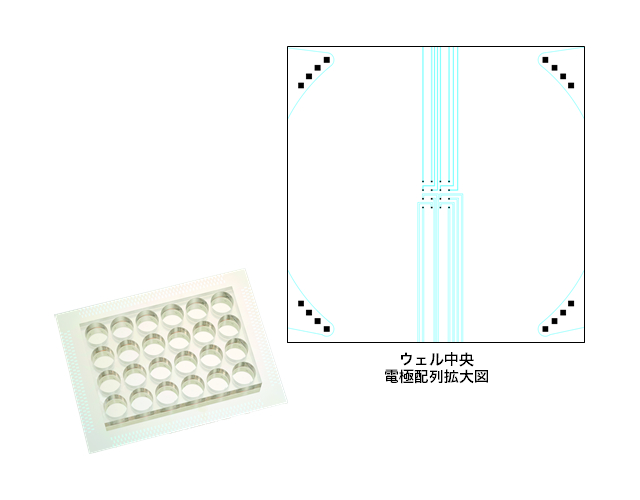
- SPECIFICATIONS
-
Materials Substrate Glass, T=0.7 mm Conducting layer ITO (Indium Tin Oxide), T=0.15 μm Insulation layer Polyimide Electrodes Carbon nanotube Well Acrylic resin General Information Substrate size 105 x 140 mm Number of recording electrodes 16/well Recording electrodes size 50 x 50 μm Recording electrodes spacing 300 μm Number of reference electrodes 16/well Reference electrodes size 200 x 200 μm Reference electrodes blocks spacing 11,9 mm Electrode impedance (f= 1kHz) Typ. 10 kΩ Maximum current output ±200 μA (t=300 μS) Maximum voltage output ±1 V Number of wells 24 Well size Φ16 mm Well height 10 mm Well volume 2 ml
MEA Plate [MED-Q2430M]
- Sixteen planar microelectrodes are arranged in the each center 24 wells on a transparent glass substrate.
- Predesignated one or two electrodes can be chosen for stimulation in each well.
- The industory's lowest-impedance microelectrodes provide excellent signal-to-noise ratio as well as stimulation capabilities.
- It is supported on MED64-Presto.
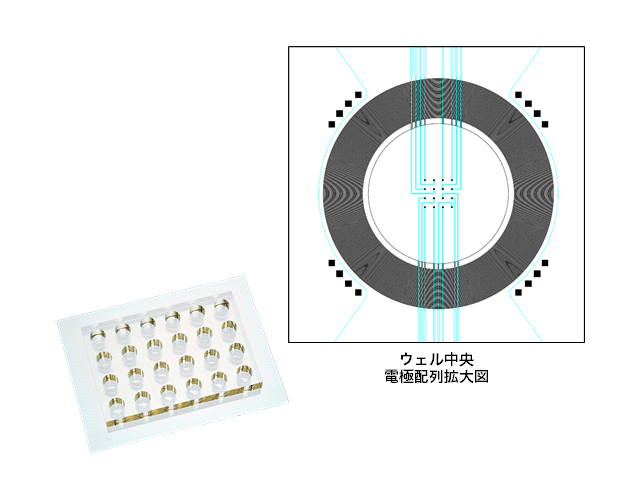
- SPECIFICATIONS
-
Materials Substrate Glass, T=0.7 mm Conducting layer ITO (Indium Tin Oxide), T=0.15 μm Insulation layer Polyimide Electrodes Carbon nanotube Well Acrylic resin General Information Substrate size 105 x 140 mm Number of recording electrodes 16/well Recording electrodes size 50 x 50 μm Recording electrodes spacing 300 μm Number of reference electrodes 16/well Reference electrodes size 200 x 200 μm Reference electrodes blocks spacing 5.4 mm Electrode impedance (f= 1kHz) Typ. 10 kΩ Maximum current output ±200 μA (t=300 μS) Maximum voltage output ±1 V Number of wells 24 Well size Φ11 mm Well height 10 mm Well volume 1 ml
MEA Plate [MED-Q4830]
- Eight planar microelectrodes are arranged in the each center of 48 wells on a transparent glass substrate.
- Predesignated one or two electrodes can be chosen for stimulation in each well.
- The industory's lowest-impedance microelectrodes provide excellent signal-to-noise ratio as well as stimulation capabilities.
- It is supported on MED64-Presto.
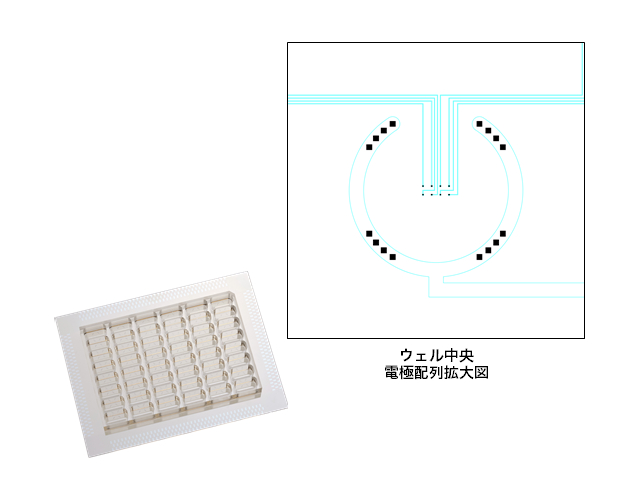
- SPECIFICATIONS
-
Materials Substrate Glass, T=0.7 mm Conducting layer ITO (Indium Tin Oxide), T=0.15 μm Insulation layer Polyimide Electrodes Carbon nanotube Well Acrylic resin General Information Substrate size 105 x 140 mm Number of recording electrodes 8/well Recording electrodes size 50 x 50 μm Recording electrodes spacing 300 μm Number of reference electrodes 16/well Reference electrodes size 200 x 200 μm Reference electrodes blocks spacing 5.4 mm Electrode impedance (f= 1kHz) Typ. 10 kΩ Maximum current output ±200 μA (t=300 μS) Maximum voltage output ±1 V Number of wells 48 Well size 7.5 x 16 mm Well height 10 mm Well volume 1 ml
MEA Plate [MED-Q615]
- Sixty-four planar microelectrodes are arranged in the each center of 6 wells on a transparent glass substrate.
- Predesignated one or two electrodes can be chosen for stimulation in each well.
- The industory's lowest-impedance microelectrodes provide excellent signal-to-noise ratio as well as stimulation capabilities.
- It is supported on MED64-Presto.

- SPECIFICATIONS
-
Materials Substrate Glass, T=0.7 mm Conducting layer ITO (Indium Tin Oxide), T=0.15 μm Insulation layer Polyimide Electrodes Carbon nanotube Well Glass General Information Substrate size 105 x 140 mm Number of recording electrodes 64/well Recording electrodes size 50 x 50 μm Recording electrodes spacing 150 μm Number of reference electrodes 16/well Reference electrodes size 200 x 200 μm Reference electrodes blocks spacing 8.5 mm Electrode impedance (f= 1kHz) Typ. 10 kΩ Maximum current output ±200 μA (t=300 μS) Maximum voltage output ±1 V Number of wells 6 Well size Φ22 mm Well height 10 mm Well volume 3.8 ml
Related Products
MED Cell Droplet 24 [MED-CRD24]
- Red marker is printed at the place corresponding to recording electrodes in each well of a 24-well MEA Plate. It can give indications of cell plating places by laying under a MEA plate.

- SPECIFICATIONS
-
Size W160 x L125 x H5 mm Weight 101 g Material Acrylic resin
MED Cell Spotter [MED-CRS01]
- Autoclavable cloning cylinder integrated MED Cell Spotter for seeding cell suspension for MED-P515A and MED-R515A. Prevents the cell suspension from spreading to reference electrodes.
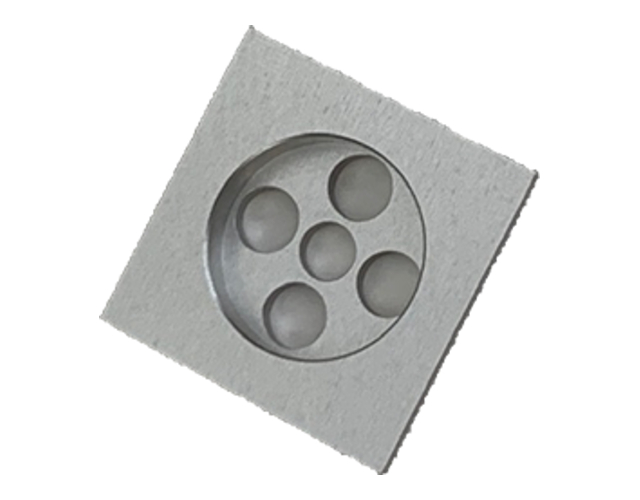
- SPECIFICATIONS
-
Size Φ22 x H10 mm
Cylinder ID: 3.5 mmWeight 0.7 g Material Polycarbonate
MED Cell Spotter [MED-CRS24L]
- Autoclavable cloning cylinder integrated MED Cell Spotter for seeding cell suspension for MED-Q2430L. Prevents the cell suspension from spreading to reference electrodes.
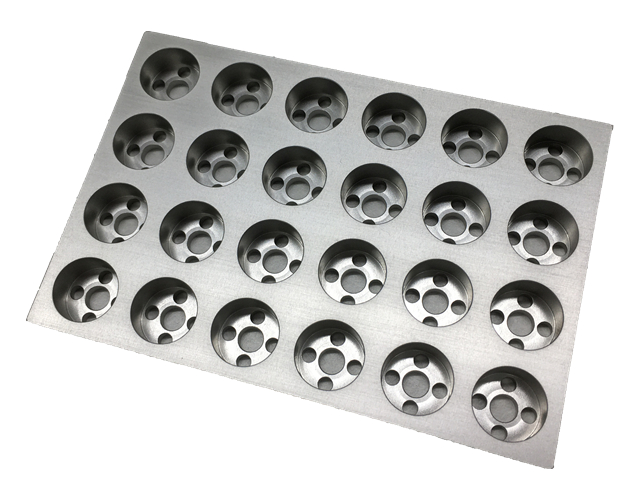
- SPECIFICATIONS
-
Size Φ16 x H10 mm
Cylinder ID: 3.5 mmWeight 0.4 g Material Polycarbonate
MED Cell Spotter [MED-CRS24L-B]
- Autoclavable cloning cylinder integrated MED Cell Spotter for brain organoid for MED-Q2430L.
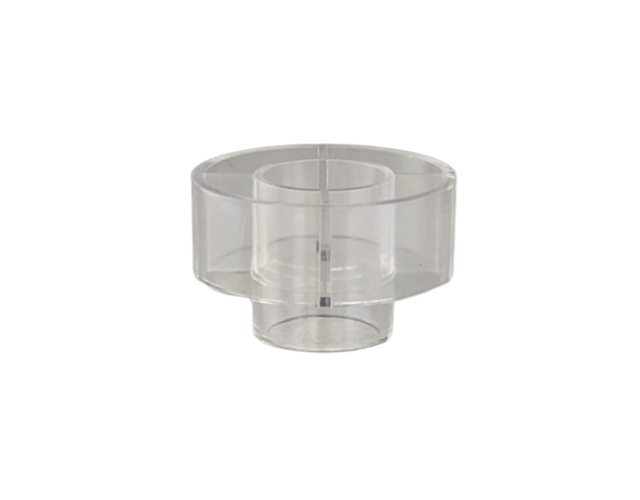
- SPECIFICATIONS
-
Size Φ16 x H10 mm
Cylinder ID: 7 mmWeight 0.51 g Material Polycarbonate
MED Cell Spotter [MED-CRS24M]
- It is the guide frame can help to stand a cloning cylinder with 5 mm of outer diameter surrounding the 16 recording electrodes in each well of a MEA Plate.
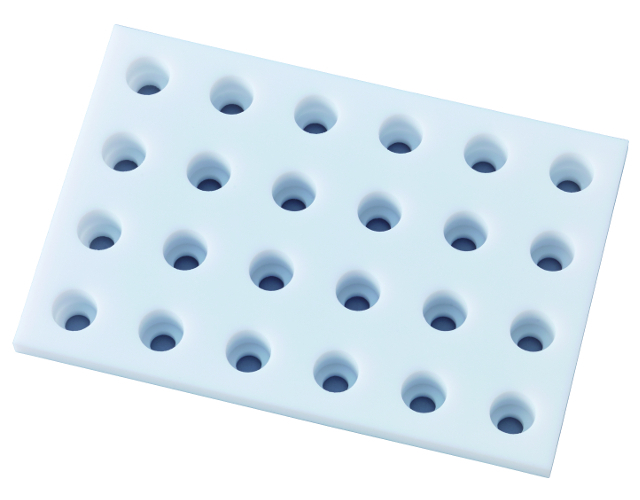
- SPECIFICATIONS
-
Size W110 x L75 x H10 mm Weight 94 g Material Aluminum
MED Cell Spotter [MED-CRS48]
- Autoclavable cloning cylinder integrated MED Cell Spotter for brain organoid for MED-Q4830.
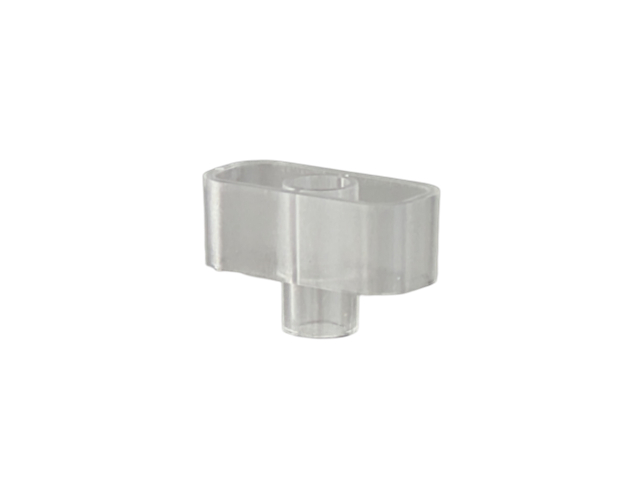
- SPECIFICATIONS
-
Size W16 x L7 x H10 mm
Cylinder ID: 3.5 mmWeight 0.33 g Material Polycarbonate

